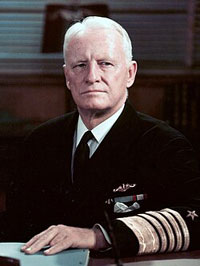
Chester William Nimitz was born in Fredericksburg in 1885 and had a childhood far from the sea. His father died just before he was born, and he was raised by his mother and paternal grandfather, Charles Nimitz. The elder Nimitz was a German immigrant and had been a sailor before he settled in Texas in the 1850s. He also had served as a captain in the Confederate Army during the Civil War. He had a profound impact on the younger Nimitz.
As he reached adulthood, he wanted to serve his country and applied for admission to the U. S. Military Academy at West Point. His congressman convinced him to apply to the U. S. Naval Academy, where he graduated seventh in his class in 1905. He served with distinction on a number of battleships and destroyers after his graduation, mostly serving in the Pacific fleet. In 1909, he was assigned to serve with the Navy’s first submarine fleet and helped with the construction of the ships and training of the earliest crews.
During World War I, he served as chief engineer on a destroyer and later served as an aide to Adm. Samuel Robison, commander of the Atlantic submarine fleet. After the war, he was given his first command, the cruiser USS Chicago. In 1926, he established the navy’s first ROTC program to ensure a steady supply of reliable, educated officers for the navy. He steadily rose through the ranks, respected for his dedication and his imagination in modernizing engine designs, submarine construction, and even mid-ocean refueling techniques.
On December 17, 1941, ten days after the disastrous attack on the Pacific fleet at Pearl Harbor, President Franklin D. Roosevelt named Nimitz commander-in-chief of the Pacific fleet. The fleet was in shambles, and Nimitz was responsible for holding back the tide of the Japanese navy threatening American shores.
He quickly rallied American ships to stop the Japanese advance on Australia with the Battle of the Coral Sea in 1942. Learning that Japan was trying to finish off the Navy, he organized a massive fleet to meet the Japanese at Midway that June. Midway was a tremendous victory for America, allowing the U. S. to recapture the Central Pacific. Japanese officials realized they had lost the war at that point but fought on.
Nimitz organized the “island-hopping” campaigns of the South Pacific as American forces fought to liberate key island groups. His tactics at the Battle of Leyte Gulf in 1944 broke the back of the remaining Japanese navy and led to the recapture of the Philippines. When Japan finally surrendered in 1945, Nimitz was on the USS Missouri to accept their capitulation.
After the war, Nimitz was named Chief of Naval Operations and oversaw the dismantling of the massive fleet the nation had built during the war. At the same time, he pushed for modernization of the fleet as oversaw the construction of the submarine USS Nautilus, the first nuclear-powered naval vessel. He retired from his duties as chief of naval operations in 1947, but his status as a fleet admiral kept him on active duty. He served as a Special Assistant to the Secretary of the Navy, advising the navy on special issues. He also served as a regent for the University of California system during the 1950s.
He died at his home in California in 1966. The nation revered the great hero after his passing. Eight communities named schools after him, including a high school in Irving and an elementary school in Kerrville. In 1971, his hometown of Fredericksburg honored him by opening the Chester Nimitz Museum which has since expanded into the National Museum of the Pacific War. In 1975, the Navy commissioned the USS Nimitz, a top-of-the-line nuclear-powered aircraft carrier, a vessel still serving to this day.

